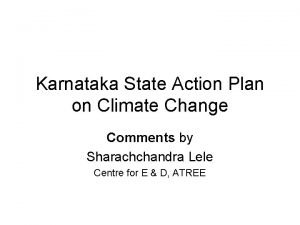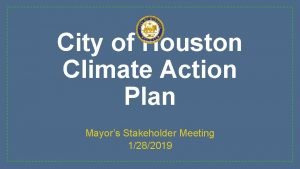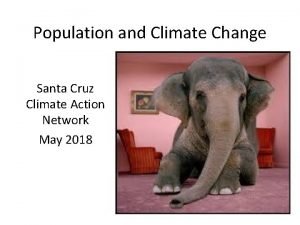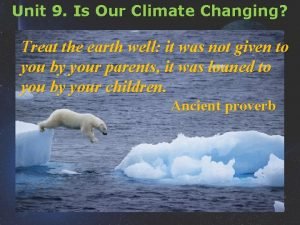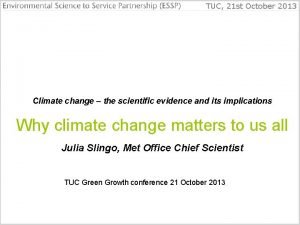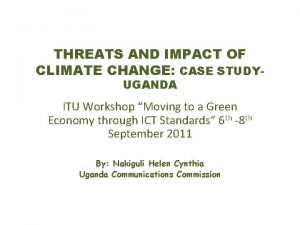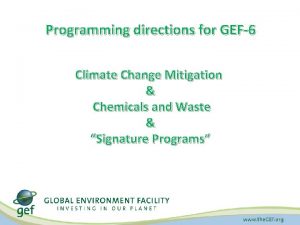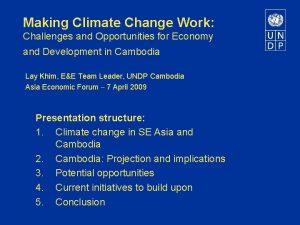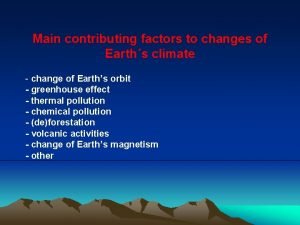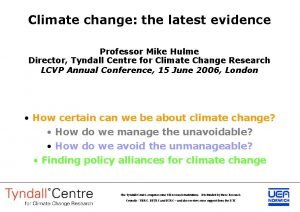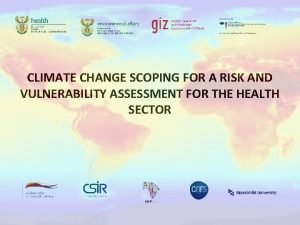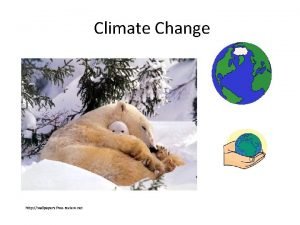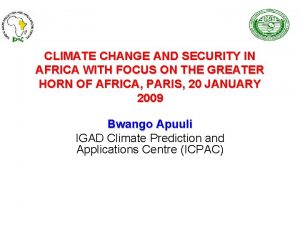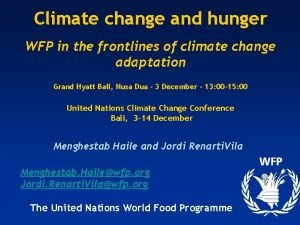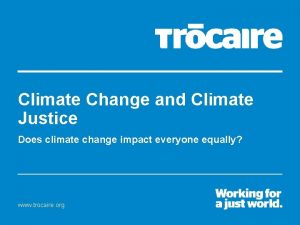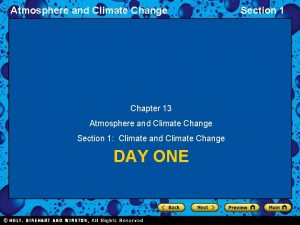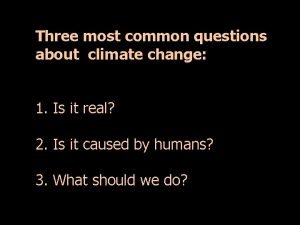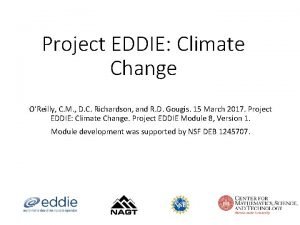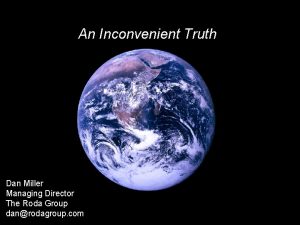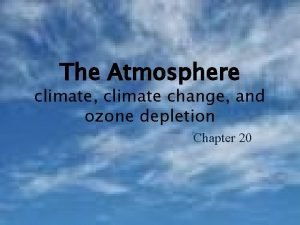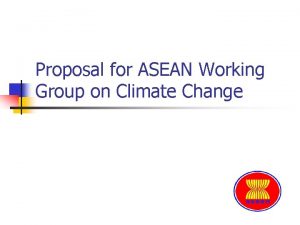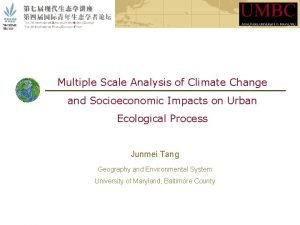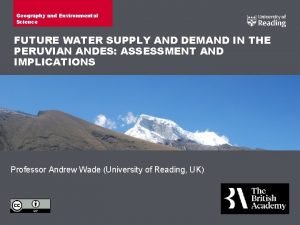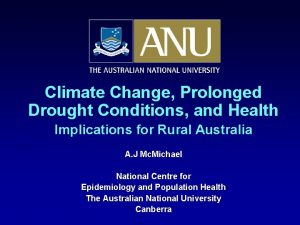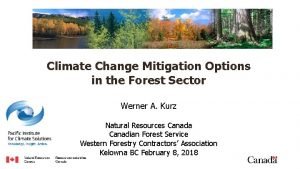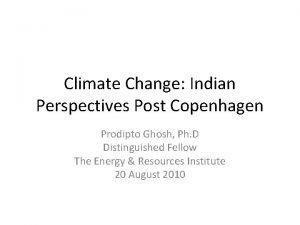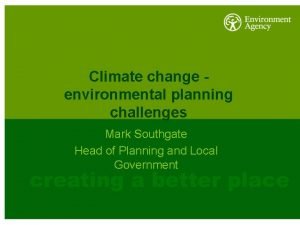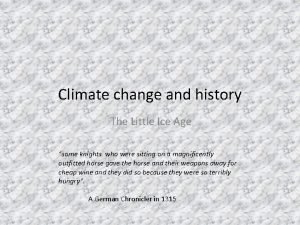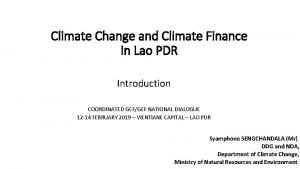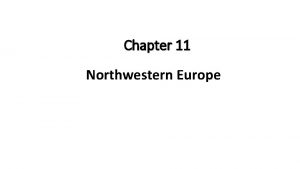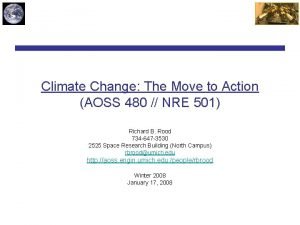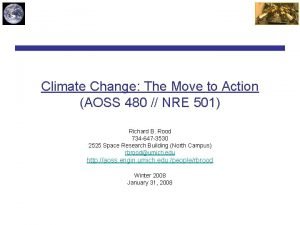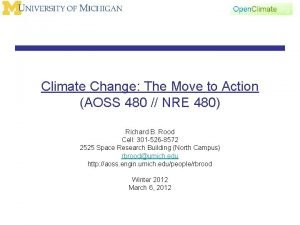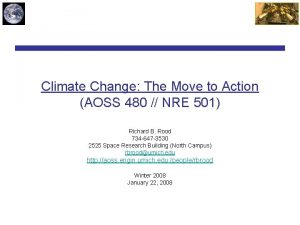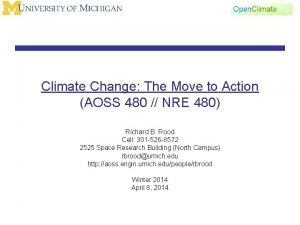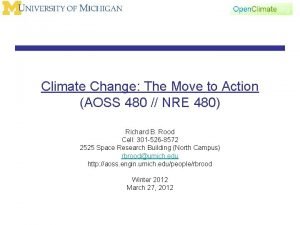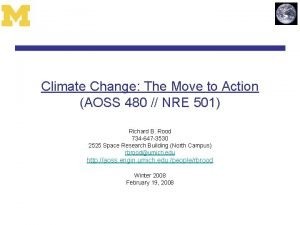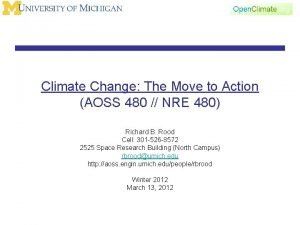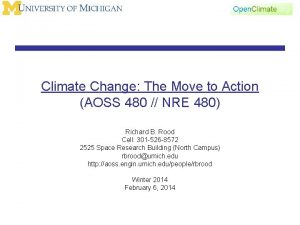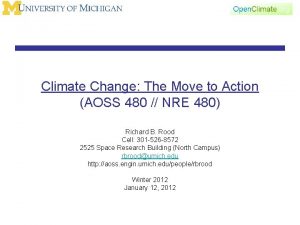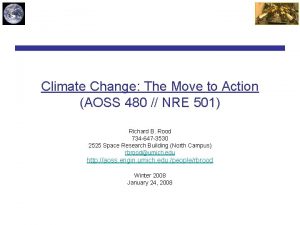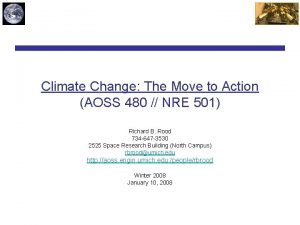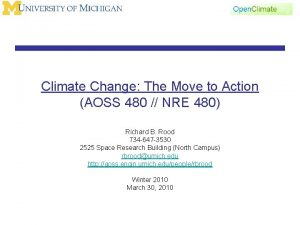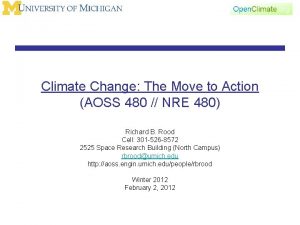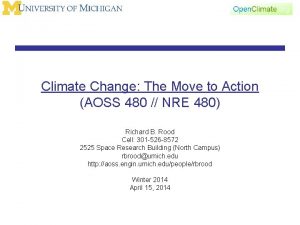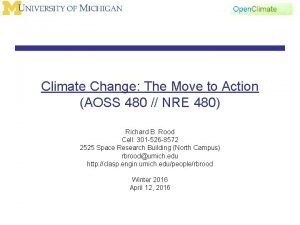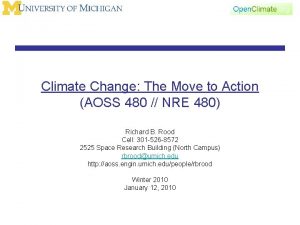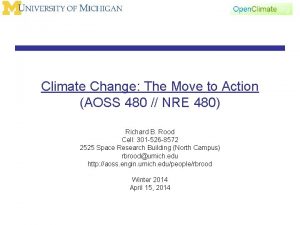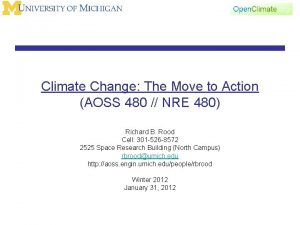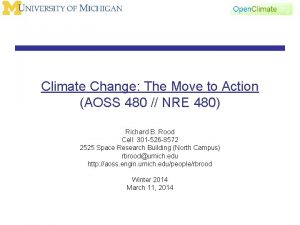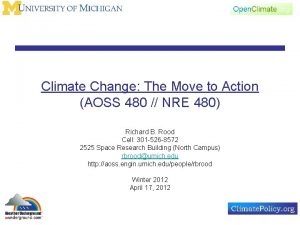Climate Change The Move to Action AOSS 480
















































- Slides: 48

Climate Change: The Move to Action (AOSS 480 // NRE 501) Richard B. Rood 734 -647 -3530 2525 Space Research Building (North Campus) rbrood@umich. edu http: //aoss. engin. umich. edu. /people/rbrood Winter 2008 January 31, 2008

Class News • A ctools site for all – AOSS 480 001 W 08 • This is the official repository for lectures • Email climateaction@ctools. umich. edu • Class Web Site and Wiki – Climate Change: The Move to Action – Winter 2008 Term • Wunderground Climate Page – Posted Introduction of the New Rough Guide – My recent series on models

Readings on Local Servers • Assigned – Mc. Carty: Ecological Consequences of Climate Change – Walther: Ecological Response to Climate Change • Of Interest – Osborn: Spatial Extent of Current Warming – Francis: Sea Ice and Water Vapor Feedback – Anderson: Little Ice Age/Baffin Island

Quik. Climate AOSS 605 • First specific readings for Quikclimate (Physical Climate Course) – Hartmann: Chapter 5: Hydrological Cycle – Oort & Rasmusson: Chapter 12: Hydrological Cycle • Short meeting after class today.

Projects • Next Thursday: Projects discussion – What topics are being discussed? – Are groups organizing? – Present a prospectus?

Lectures coming up • http: //www. snre. umich. edu/events

Outline of Lecture • Models and Attribution – Consistency of data and predictions in the past 100 years. • Predictions for the next 100 years • The nature of abrupt climate change

Figure TS. 23

Figure SPM. 4

Ocean • Time scales in ocean much longer • Oceanography and ocean modeling has shorter history of comprehensive observations and modeling. • Exchanges in ocean and atmosphere not fully characterized: – Are they adequately “constrained” by knowledge?

Atlantic Ocean Surface Temperature Related to Hurricane Arguments

Heat in the Ocean

Calculated Radiative Forcing

Radiative Forcing IPCC 2007

Comparison of “Change” to Balance ~2 out of 340 W / m 2 IF WE CHOOSE TO DO SOMETHING ABOUT THIS, THEN CHANGE ENERGY BALANCE CHANGE ABSORPTION OF RADIATIVE ENERGY CHANGE REFLECTION OF RADIATIVE ENERGY

Changes in Precipitation

Observed Precipitation Change: Late 20 th Century

Start to think about the 2100 predictions

As people sitting here on earth, what climate parameters/events do we care about? • Temperature • Water – Precipitation – Evaporation – Humidity • Air Composition – Air quality – Aerosols – Carbon dioxide • Winds • Clouds / Sunlight • Sea-level Rise • Droughts • Floods • Extreme Weather


PCC 2001 Remember the simple model A 1 B T B 2 B 1 Note: There i consistency from many models, man scenarios, that there will be warming. (1. 5 – 5. 5 C) Also, it’s still going up in 2100!

Temperature Projections 2100 A 1 B ? B 2 B 1 IPCC 2007

Temperature Projections 2100 IPCC 2007

PCC 2001 Remember the simple model A 1 B T B 2 B 1 Note: There i consistency from many models, man scenarios, that there will be warming. (1. 5 – 5. 5 C) Also, it’s still going up in 2100!

PCC 2001 Temperature in 2100 or different scenarios Temperature when CO 2 equilibrium is achieved. (Longer prediction) Again, all predictions are of warming.

IPCC 2001

Temperature Predictions 2100 IPCC 2007

Systematic Temperature Changes • Global Temperature increase 1. 5 – 4. 5 C • Poles warm more faster than globe, especially the North Pole. • Land warms faster than ocean. • Night warms faster than day • Spring starts earlier • Autumn starts later IPCC 2001: Has this changed significantly?

IPCC 2001

Precipitation Prediction 2100 IPCC 2007

Water • Water vapor in atmosphere will increase (It’s a greenhouse gas. ) • Precipitation will increase • Evaporation will increase (It’s warmer. ) • Snow cover will be less over most continents. • Snow could increase in Greenland Antarctica? IPCC 2001: Has this changed significantly?

Surface Elevation Change of Ice Caps

Sea Level Projections 2100 IPCC 2007

IPCC 2007: A 2 0. 23 -0. 51 IPCC 2007: B 2 0. 20 -0. 43

Sea level predictions • This was most controversial part of the report among scientists at the time of release. – Note the report is heavily qualified • “do not include full effects of changes in ice sheet flow” – Basis lacking in literature. – “Larger values cannot be excluded. . . ” • If the current trend remains and is linear add 0. 1 – 0. 2 meters.

Changes in Weather

Very Wet Days

With confidence • The surface temperature will rise. • Sea level will rise – Ice will melt • Weather will change – Precipitation intensity and spatial distribution will change – Evaporation will increased because it is warmer • I would posit, this has been observed, and to be consistent with model predictions for the past 150 years. Going into the future these predictions are robust in the sense of sign, and approximate magnitude.

Abrupt climate change • The predictions and observations so far are either in the sense of: – Relatively small changes in the dynamic balance of the climate system – Incremental changes to the stable climate. • What about “abrupt” climate change?

Abrupt climate change • Changes in the ocean circulation. – Remember Younger Dryas in Lecture 6 • Remember the ice-age turn around: – Need some sort of positive feedback to amplify the solar forcing • Ice-albedo feedback // – Sea ice collapse in Arctic? – Land ice sheet collapse sea level rise • Sudden release or absorption of greenhouse gas from ocean • Sudden release or absorption of greenhouse gas from land – Permafrost • Sudden change in the biological balance of plants and animals – Ocean temperature and acidification

Abrupt Climate Change • Most scenarios of abrupt climate change are related to a phase change in some way or another. Does the albedo change quickly? Is there a change in the fresh water in the ocean? Is there a release of gas stored in something that is frozen? • It is also possible to define rapid changes in ocean (land? ) ecosystems, that leads to composition changes in the atmosphere. Biology – sensitive to temperature, water, salinity, ph, etc. Lamont-Doherty: Abrupt Climate Change

When people talk about sudden climate change, what do they mean? (An excursion to the North Atlantic) • Remember that the atmospheres and ocean carry heat from the equator to the pole. – This is done at preferential locations. – One especially important mechanism of heat transport is the Gulf Stream, along the eastern coast of the U. S, which transports heat to the North Atlantic. This keeps much of Europe much warmer than it would be based on the position of the sun. – The Gulf Stream is part of a large organized circulation in the oceans. • Connects north and south • Connects top and bottom of ocean (which is not very common) – This organized circulation is sometimes called the ocean “conveyor” belt. It is named thermohaline circulation because it depends on both thermal structure and the saltiness (“haline”) of the water.

The Thermohaline Circulation (THC) (Global, organized circulation in the ocean) (The “conveyer belt”, “rivers” within the ocean) Blue shading, low salt Where there is localized exchange of water between the surface and the deep ocean (convection) Green shading, high salt Warm, surface currents. Cold, bottom currents. From Jianjun Yin, GFDL, see J. Geophysical Research, 2006

Some aspects of thermohaline circulation • Salt is important to the density of sea water. • Warm, salty water on the surface moves to high northern and southern latitudes, where it sinks. • The area where there is strong, localized exchange, bottom water currents develop which return cold water towards the equator (heat exchange). • The area where there is strong localized exchange is significantly warmer than it would be in the absence of the ocean currents. (see next figure) • Saltiness is very important. If the North Atlantic were flooded with fresh water from Greenland ice melting or much more precipitation, then thermohaline circulation might shut down. – There is evidence that this happened before (look up the Younger Dryas) – Hence melting of Greenland impacts both sea-level rise and thermohaline circulation

Importance of the Thermohaline Circulation in the Present Climate If thermohaline circulation shut down, then the climate, the mean surface temperature, would be abruptly and significantly changed. • The deviation of the surface air temperature from the zonal average (NCAR/NCEP reanalyses); • The THC is responsible for most northward heat transport in the Atlantic (> 1 Peta. Watts = 1015 Watts); • High surface air temperature over the North Atlantic and Europe From Jianjun Yin, GFDL, see J. Geophysical Research, 2006

Some model predictions of what would happen if thermohaline circulation shutdown • From Jianjun Yin, GFDL, see J. Geophysical Research, 2006 • Fresh water is added in the model simulation to the North Atlantic, in the vicinity of Greenland Iceland. • With the addition of fresh water thermohaline circulation shuts down • There are global consequences – See plots below.

• • • Predicted Sea Surface Temperature Bipolar Seesaw 3 o. C decrease NA Extension of icy seawater and sea ice coverage in North Atlantic Spread of warmer seawater via ACC Feedback on the THC intensity (This dipole has the characteristic of a dynamical response) Predicted Sea Surface Salt (SSS) 1. 2 psu decrease in 50~70 o. N belt SA and Gulf of Mexico become more saline Sharp SSS gradient at 40 o. N Labrador Sea: the most susceptible region to freshwater perturbation Predicted Sea Ice Thickness increases and coverage extends in the Labrador Sea Thickness decreases in the Nordic Seas the Barents Sea and the Weddell Sea due to enhancement of deep convection (part of a dynamical response? ) From Jianjun Yin, GFDL, see J. Geophysical Research, 2006

Abrupt Climate Change • This is a subject of current high interest. – Is there a “dangerous” threshold that could have extremely rapid, decades, impact? – Is there a dangerous threshold that we could avoid by mitigation? – Should we plan for this contingency?
 Climate change 2014 mitigation of climate change
Climate change 2014 mitigation of climate change 480+480
480+480 Karnataka state action plan on climate change
Karnataka state action plan on climate change What has roads but no cars rivers but no water
What has roads but no cars rivers but no water Lara cottingham city of houston
Lara cottingham city of houston Tempe climate action plan
Tempe climate action plan Santa cruz climate action network
Santa cruz climate action network Persuasive essay about global warming
Persuasive essay about global warming Brainpop climate types
Brainpop climate types Climate change meaning and definition
Climate change meaning and definition Chapter 13 atmosphere and climate change section 1
Chapter 13 atmosphere and climate change section 1 Unit 9 climate change
Unit 9 climate change Conclusion of climate change
Conclusion of climate change Conclusion of climate change
Conclusion of climate change Conclusion of climate change
Conclusion of climate change Mathematics of climate change
Mathematics of climate change Globalization ap world history definition
Globalization ap world history definition Climate change mitigation
Climate change mitigation 414 climate change
414 climate change Conclusion of climate change
Conclusion of climate change Factors of climate change
Factors of climate change Human causes of climate change
Human causes of climate change Example of conceptual framework in accounting
Example of conceptual framework in accounting Uk climate change
Uk climate change Climate change interview
Climate change interview Factors affecting global warming
Factors affecting global warming Conclusion of climate change
Conclusion of climate change Conclusion of climate change
Conclusion of climate change Climate change causing droughts
Climate change causing droughts Chapter 13 atmosphere and climate change
Chapter 13 atmosphere and climate change Climate change hypothesis
Climate change hypothesis How global warming works
How global warming works Financing education in a climate of change
Financing education in a climate of change Climate change pathos
Climate change pathos Dan miller climate change
Dan miller climate change Un climate change
Un climate change What does rhetorical mean
What does rhetorical mean Asean working group on climate change
Asean working group on climate change Climate change
Climate change How does climate change affect us
How does climate change affect us Climate change national security threat
Climate change national security threat How climate change
How climate change Climate change sydney
Climate change sydney Climate change activities
Climate change activities Responsibility for climate change
Responsibility for climate change Act now climate change
Act now climate change 1816 year without summer
1816 year without summer Climate change activities
Climate change activities Countries in northwestern europe
Countries in northwestern europe


